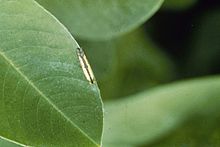- Elasmopalpus
-
Elasmopalpus 
Adult male 
Adult female Scientific classification Kingdom: Animalia Phylum: Arthropoda Class: Insecta Order: Lepidoptera Family: Pyralidae Genus: Elasmopalpus
C. É. Blanchard, 1852[1][2]Species: E. lignosellus Binomial name Elasmopalpus lignosellus
Zeller, 1848Synonyms - Pempelia lignosella
- Pempelia tartarella Zeller, 1872
- Pempelia tartarellus
- Dasypyga carbonella Hulst, 1888
- Dasypyga carbonellus
- Pempelia incautella Zeller, 1872
- Elasmopalpus incautellus
- Pempelia major Zeller, 1874
- Elasmopalpus major
- Elasmopalpus anthracellus Ragonot, 1888
- Elasmopalpus puer Dyar, 1919
The Lesser Cornstalk Borer (Elasmopalpus lignosellus) is a species of snout moth. It was described by Zeller in 1852.[1] It is found from the southern United States to Mexico, Central America and South America (Colombia, Venezuela, Brazil, Peru, Argentina and Chile). It is also found on the Bahamas.
The wingspan is 17-25 mm. Adults are generally brownish with narrow and elongate forewings with oblique distal margins. The forewings are yellow ochre to light brown in males and dark brown in females. The hindwings are whitish with grey to brown anterior and distal margins.
The larvae feed on a wide range of plants but prefer grasses. Recorded host plants include a number of economically important plants such as Phaseolus vulgaris, Beta vulgaris, Brassica oleracea var. capitata, Cucumis melo, Cyperus esculentus, Zea mays, Vigna unguiculata, Phaseolus lunatus, Avena sativa, Pisum sativum, Arachis hypogaea, Capsicum annuum, Oryza sativa, Secale cereale, Sorghum bicolor, Glycine max, Sorghum sudanense, Saccharum officinarum, Ipomoea batatas, Lycopersicon esculentum, Brassica rapa and Triticum aestivum.[3] They tunnel into the crown of their host plant, severely weakening large plants and often killing young seedlings. They spin silken tubes near the soil surface for protection. On peanuts, they will feed on any portion of the plant that contacts the soil. The species overwinters as a larva or pupa in the soil.[4]
Gallery
References
- ^ a b "World Pyraloidea Database". Globiz.pyraloidea.org. http://globiz.pyraloidea.org/Pages/Reports/TaxonReport.aspx. Retrieved 2011-10-07.
- ^ "Elasmopalpus at funet". Nic.funet.fi. 2002-10-25. http://www.nic.funet.fi/pub/sci/bio/life/insecta/lepidoptera/ditrysia/pyraloidea/pyralidae/phycitinae/elasmopalpus/index.html. Retrieved 2011-10-07.
- ^ "Factsheet at Florida Featured Creatures". Edis.ifas.ufl.edu. http://edis.ifas.ufl.edu/in312. Retrieved 2011-10-07.
- ^ "Bug Wood". Wiki.bugwood.org. 2010-02-01. http://wiki.bugwood.org/Elasmopalpus_lignosellus. Retrieved 2011-10-07.

This Pyralidae-related article is a stub. You can help Wikipedia by expanding it.




